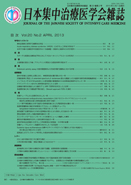Volume 20, Issue 2
Displaying 1-31 of 31 articles from this issue
- |<
- <
- 1
- >
- >|
HIGHLIGHTS IN THIS ISSUE
-
2013Volume 20Issue 2 Pages 209-211
Published: April 01, 2013
Released on J-STAGE: May 14, 2013
Download PDF (392K) -
2013Volume 20Issue 2 Pages 211-212
Published: April 01, 2013
Released on J-STAGE: May 14, 2013
Download PDF (387K) -
2013Volume 20Issue 2 Pages 213-215
Published: April 01, 2013
Released on J-STAGE: May 14, 2013
Download PDF (393K)
REVIEW ARTICLES
-
2013Volume 20Issue 2 Pages 217-226
Published: April 01, 2013
Released on J-STAGE: May 14, 2013
Download PDF (394K)
COMMENTARY ARTICLE
-
2013Volume 20Issue 2 Pages 227-234
Published: April 01, 2013
Released on J-STAGE: May 14, 2013
Download PDF (416K)
ORIGINAL ARTICLES
-
2013Volume 20Issue 2 Pages 235-242
Published: April 01, 2013
Released on J-STAGE: May 14, 2013
Download PDF (464K)
CASE REPORTS
-
2013Volume 20Issue 2 Pages 243-246
Published: April 01, 2013
Released on J-STAGE: May 14, 2013
Download PDF (812K) -
2013Volume 20Issue 2 Pages 247-252
Published: April 01, 2013
Released on J-STAGE: May 14, 2013
Download PDF (550K) -
2013Volume 20Issue 2 Pages 253-256
Published: April 01, 2013
Released on J-STAGE: May 14, 2013
Download PDF (744K) -
2013Volume 20Issue 2 Pages 257-260
Published: April 01, 2013
Released on J-STAGE: May 14, 2013
Download PDF (416K) -
2013Volume 20Issue 2 Pages 261-264
Published: April 01, 2013
Released on J-STAGE: May 14, 2013
Download PDF (1094K) -
Acid-base balance in post-esophagectomy patients: a quantitative analysis using the Stewart-approach2013Volume 20Issue 2 Pages 265-269
Published: April 01, 2013
Released on J-STAGE: May 14, 2013
Download PDF (416K)
BRIEF REPORTS
-
2013Volume 20Issue 2 Pages 271-272
Published: April 01, 2013
Released on J-STAGE: May 14, 2013
Download PDF (1035K) -
2013Volume 20Issue 2 Pages 273-274
Published: April 01, 2013
Released on J-STAGE: May 14, 2013
Download PDF (204K) -
2013Volume 20Issue 2 Pages 275-276
Published: April 01, 2013
Released on J-STAGE: May 14, 2013
Download PDF (322K) -
2013Volume 20Issue 2 Pages 277-278
Published: April 01, 2013
Released on J-STAGE: May 14, 2013
Download PDF (358K) -
2013Volume 20Issue 2 Pages 279-280
Published: April 01, 2013
Released on J-STAGE: May 14, 2013
Download PDF (449K) -
2013Volume 20Issue 2 Pages 281-282
Published: April 01, 2013
Released on J-STAGE: May 14, 2013
Download PDF (265K) -
2013Volume 20Issue 2 Pages 283-284
Published: April 01, 2013
Released on J-STAGE: May 14, 2013
Download PDF (490K) -
2013Volume 20Issue 2 Pages 285-286
Published: April 01, 2013
Released on J-STAGE: May 14, 2013
Download PDF (385K) -
2013Volume 20Issue 2 Pages 287-288
Published: April 01, 2013
Released on J-STAGE: May 14, 2013
Download PDF (253K) -
2013Volume 20Issue 2 Pages 289-290
Published: April 01, 2013
Released on J-STAGE: May 14, 2013
Download PDF (420K) -
2013Volume 20Issue 2 Pages 291-292
Published: April 01, 2013
Released on J-STAGE: May 14, 2013
Download PDF (291K) -
2013Volume 20Issue 2 Pages 293-294
Published: April 01, 2013
Released on J-STAGE: May 14, 2013
Download PDF (323K)
LETTERS
-
2013Volume 20Issue 2 Pages 295
Published: April 01, 2013
Released on J-STAGE: May 14, 2013
Download PDF (245K) -
2013Volume 20Issue 2 Pages 296-297
Published: April 01, 2013
Released on J-STAGE: May 14, 2013
Download PDF (244K)
INVESTIGATION REPORTS
-
2013Volume 20Issue 2 Pages 299-302
Published: April 01, 2013
Released on J-STAGE: May 14, 2013
Download PDF (298K) -
2013Volume 20Issue 2 Pages 303-305
Published: April 01, 2013
Released on J-STAGE: May 14, 2013
Download PDF (215K)
COMMITTEE REPORTS
-
2013Volume 20Issue 2 Pages 307-319
Published: April 01, 2013
Released on J-STAGE: May 14, 2013
Download PDF (2167K) -
2013Volume 20Issue 2 Pages 320-328
Published: April 01, 2013
Released on J-STAGE: May 14, 2013
Download PDF (483K) -
2013Volume 20Issue 2 Pages 329-334
Published: April 01, 2013
Released on J-STAGE: May 14, 2013
Download PDF (356K)
- |<
- <
- 1
- >
- >|
